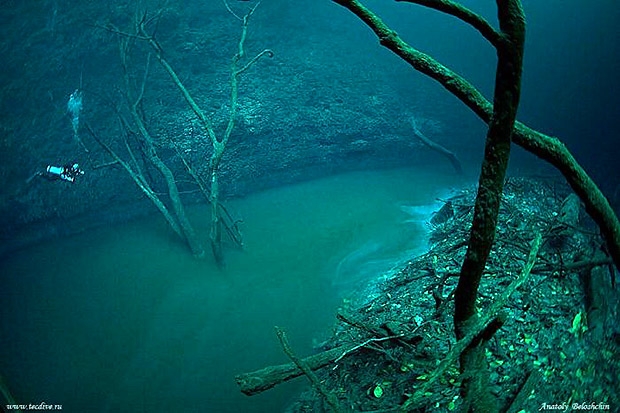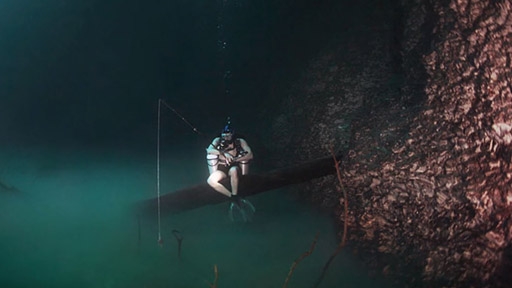
There’s an underwater river flowing under the ocean in Mexico, and you’ve got to see it to believe it.
Located just 15 minutes away from Tulum on the Yucatan Peninsula, this submerged natural wonder will blow your mind.
Approximately 180 feet below the ocean surface, this freshwater river is separated from the saltwater above by a layer of hydrogen sulfate. Because of the limited visibility during the descent through this hydrogen sulfate “cloud,” only advanced SCUBA divers are allowed to make this dive.
The cloudy layer is termed a “halocline,” an area where freshwater and saltwater meet. The haze is a due to the sharp contrast in salinity.
Once through the fog, fallen trees and leaves can be seen on either side of the river.

This is just one of many cenotes (natural sinkholes) that formed as a result of groundwater being exposed by collapsing limestone bedrock nearly 6,500 years ago. Cenotes are especially common in the Yucatan Peninsula of Mexico, and because of their mystic and unique qualities were once used by the Maya for sacrificial offerings.
This particular location is called Cenote Angelita, meaning “little angel” in Spanish.
Who’s up for diving here?
WATCH NEXT: Weirdest Creatures Filmed Beneath Oil Rigs
<--!
READ MORE: 6 Most Surreal Underwater Discoveries
–>

Despite the fact that most of the earth’s surface (71%) is covered by water, what lies beneath is still largely a mystery. Humans have explored less than 5% of the world’s oceans, which hold nearly all of the water on our planet. Yet even with our limited underwater expeditions, we have already discovered some amazing things.
Check out some of the most surreal underwater places ever discovered…
Take the Yonaguni Monument, off the coast of a Japanese island. These strange subsurface ledges, pillars, wall and star-shaped platform are believed by many to be some sort of ancient manmade architecture; but no one knows for certain what they are, or were.

There is also a surreal underwater forest, in the mountains of Kazakhstan, submerged after an earthquake created a natural dam.
The cold water has preserved the trees, and the limestone deposits give the water a mystical turquoise hue.

The Antikythera Mechanism was also pulled from the deep… this artifact is an analogue computer and model of the solar system used to predict astronomical positions and act as a calendar. It was built sometime between 150 and 205 BC, and the technology and knowledge demonstrated in the mechanism was lost to civilization and only appeared again in Europe during the fourteenth century.
It was discovered in a shipwreck off the coast of the Greek island Antikythera.
 Image: Wikimedia Commons
Image: Wikimedia Commons
Scientists were perplexed after finding these underwater crop circles off the coast of Japan, and it took almost a decade to figure out their origin.

Male pufferfish construct these elaborate designs to act as nests and attract females to lay their eggs there. They design the ornate patterns and even decorate the edges with shells and pieces of coral.

Imagine seeing this while you’re swimming in a lake? There is an entire city submerged in a lake in China. Shicheng, the “Lion City,” was built during the Eastern Han Dynasty (AD 25-200) and a hydroelectric project in 1959 created the Qiandao Lake that now covers it.
 Full video here.
Full video here.
The ancient city remains undisturbed, about a hundred feet below the surface, although the lake itself is a popular tourist destination.
 Image: Wikimedia Commons
Image: Wikimedia Commons
Maybe the most incredible underwater find can only be truly appreciated from a satellite view high above…the largest submarine canyon in the world, the Zhemchug Canyon, lies below the Bering Sea.

It has a vertical relief of 8,530 feet and is deeper than the Grand Canyon. It is so bit that it’s impossible to take in its magnitude as a whole unless viewed from the sky.




